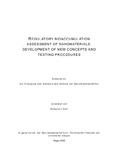Citation link:
http://dx.doi.org/10.25819/ubsi/9891Files in This Item:
| File | Description | Size | Format | |
|---|---|---|---|---|
| Dissertation_Sebastian_Kuehr.pdf | 15.91 MB | Adobe PDF |  View/Open |
| Dokument Type: | Doctoral Thesis | metadata.dc.title: | Regulatory bioaccumulation assessment of nanomaterials. Development of new concepts and testing procedures | Other Titles: | Regulatorische Bioakkumulationsbewertung von Nanomaterialien. Entwicklung neuer Konzepte und Testmethoden | Authors: | Kühr, Sebastian | Institute: | Fakultät IV - Naturwissenschaftlich-Technische Fakultät | Free keywords: | Regulatorische Biakkumulationsbewertung, Testkonzepte, Bioaccumulation, Nanomaterials, Regulatory Bioaccumulation Assessment, Invertebrates, Test concepts | Dewey Decimal Classification: | 570 Biowissenschaften; Biologie | GHBS-Clases: | VOSC UQNU VNNS |
Issue Date: | 2021 | Publish Date: | 2021 | Abstract: | Die besonderen Eigenschaften und das breite Spektrum an Anwendungsmöglichkeiten von Nanomaterialien haben dazu geführt, dass sie aus unserem Alltag nicht mehr wegzudenken sind. Die Verwendung von Nanomaterialien (NMs) in mittlerweile fast allen Industriezweigen hat die Nanotechnologie zu einem großen und immens wachsenden Wirtschaftszweig werden lassen. Das Volumen an NMs, die jährliche produziert werden, und in vielen Produkten Ver-wendung finden, liegt bei mehreren Millionen Tonnen. NMs können über das Abwasser in die aquatische Umwelt gelangen, wo sie von den dort leben Organismen aufgenommen, akkumu-liert und über die Nahrungskette angereichert werden können. Daher unterliegen NMs wie anderen chemische Industrieprodukte einer Umweltrisikobewer-tung inklusive der Beurteilung ihres Potenzials sich in der Umwelt anzureichern. Die aktuell dafür verwendeten Testsysteme wie auch die Bewertungsschemata wurden jedoch nicht für die Testung von NMs entwickelt. Zudem würde für die Testung aller NMs mit den üblichen Methoden eine enorme Menge an Fischen benötigt und sich somit neben der finanziellen und logistischen Herausforderung auch eine ethische Problematik ergeben. In den Studien dieser Arbeit wurden daher Testsysteme entwickelt, welche die Bestimmung des Bioakkumulationspotenzials von NMs mittels wirbelloser Tiere wie Muscheln und Amphi-poden ermöglicht. Hierzu wurde eigens eine Testanlage entwickelt, die eine konstante und stabile Exposition mit NMs ermöglicht. Es wurden zudem Studien mit Fischen durchgeführt, um die im neuen Testsystem mit wirbellosen Tieren erzielten Ergebnisse vergleichen zu kön-nen. Mittels Einzelpartikel-ICP-MS und angepasster Methoden der korrelativen Mikroskopie konnte am Beispiel von Silbernanopertikeln (AgNPs) gezeigt werden, dass die Akkumulation von Metallen im Gewebe der Tiere nach Exposition über das Futter und das Wasser primär über die Aufnahme von Ionen erfolgt, welche von den NMs freigesetzt werden. Laborstudien mit der Körbchenmuschel Corbicula fluminea und der Süßwasseramphipode Hyalella azteca haben gezeigt, dass benthischen Invertebraten vermutlich eine Schlüsselrolle im Transfer von NMs in der Nahrungskette zukommt. Unter Berücksichtigung der entwickelten Nicht-Wirbeltiertests wurde ein gestuftes Bewer-tungskonzept für die Beurteilung des Bioakkumulationspotenzials von NMs entwickelt, wel-ches die Ergebnisse aus Bioakkumulationsstudien mit H. azteca integriert. Regulatorische Endpunkte für die Bewertung der Bioakkumulation von NMs wurden entwickelt, welche den Aufnahmeweg von NMs in den Testorganismus berücksichtigen und somit eine eindeutige Bewertung der NMs als „bioakkumulierend“ oder „nicht-bioakkumulierend“ ermöglichen. Mit-tels der entwickelten Testmethoden kann zukünftig möglicherweise auf einen Teil der heute noch benötigten Fischtests verzichtet werden, ohne die Qualität der regulatorischen Bewer-tung zu beeinträchtigen. The special properties and the wide range of possible applications of nanomaterials (NMs) make them an essential part of our everyday life. The use of nanomaterials in almost all branches of industry has made nanotechnology a large and immensely growing market. The volume of NMs produced annually and used in many products is about several million tons. However, this also means that large quantities of these NMs find their way into the environ-ment. NMs can reach the environment via wastewater, where they can be ingested, enriched and passed on through the food chain by aquatic organisms. Therefore, NMs, like other chemical industrial products, are subject to regulation and risk as-sessment including investigations on their potential to accumulate in the environment. Howev-er, the test systems and assessment schemes currently used for this purpose were not de-veloped for NMs. In addition, testing with the established method requires an enormous amount of fish and thus poses an ethical problem and a financial and logistical challenge. In the studies of this thesis, therefore, test systems were developed which allow the determi-nation of the bioaccumulation potential of NM using invertebrates such as filtering bivalves or amphipods. For this purpose, a test system was developed which allows a constant and sta-ble exposure. In addition, studies with fish were conducted to compare the results with those obtained with invertebrates exposed to NMs in the new test system. However, using single particle ICP-MS and adapted methods of correlative microscopy, it could be shown by the example of silver nanoparticles (AgNPs) that the accumulation of met-als after dietary and aqueous exposure can be primarily explained by the uptake of ions re-leased by the NMs. The results of the laboratory studies showed that invertebrates are not only well suited for bioaccumulation studies, they also provided a clear indication on the role of benthic invertebrates regarding the transfer of NMs in the (aquatic) food chain. A new assessment scheme for the evaluation of the bioaccumulation potential of NMs was developed integrating the new H. azteca bioaccumulation test. Modified regulatory endpoints are suggested considering the uptake pathways of NMs and allowing a clear definition of the NMs as “bioaccumulative” or “non-bioaccumulative”. By means of the developed methods and the assessment scheme it might be possible in the future to reduce the amount of fish without impairing the quality of the regulatory risk assessment. |
Description: | Kumulative Dissertation |
DOI: | http://dx.doi.org/10.25819/ubsi/9891 | URN: | urn:nbn:de:hbz:467-18818 | URI: | https://dspace.ub.uni-siegen.de/handle/ubsi/1881 | License: | http://creativecommons.org/licenses/by-nc/4.0/ |
| Appears in Collections: | Hochschulschriften |
This item is protected by original copyright |
Page view(s)
444
checked on Nov 25, 2024
Download(s)
117
checked on Nov 25, 2024
Google ScholarTM
Check
Altmetric
This item is licensed under a Creative Commons License


